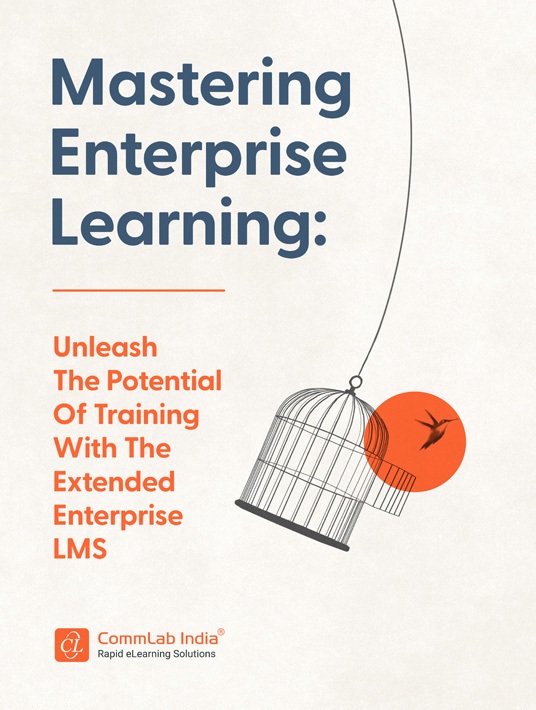What Is Extended Enterprise Learning?
Extended enterprise learning is a strategic initiative focused on delivering training and development opportunities beyond the confines of an organization’s internal workforce to include external stakeholders. This approach recognizes that learning and knowledge-sharing are essential for fostering collaboration, improving performance, and driving mutual success across the extended network of individuals and entities associated with the organization.

eBook Release
Mastering Enterprise Learning: Unleash The Potential Of Training With The Extended Enterprise LMS
Delve into the dynamic realm of extended enterprise learning, exploring its myriad challenges and offering innovative solutions to empower your organization.
Key Stakeholders And Their Primary Learning Needs
- Partners: External partners such as vendors, suppliers, distributors, and contractors collaborate closely with the organization and benefit from training programs that align with their roles, products, or services.
- Customers: Providing training to customers enhances their product knowledge, promotes brand loyalty, and improves their overall experience. Customer training may include onboarding, product tutorials, and troubleshooting guides.
- Franchisees: Franchisees operate under the umbrella of the organization’s brand and require training on operational procedures, customer service standards, and brand compliance to ensure consistency across locations.
- Channel Partners: Resellers, dealers, and channel partners play a vital role in distributing the organization’s products or services. Training programs for channel partners focus on sales techniques, product features, and market trends to drive sales performance.
Why is Extended Enterprise Learning Crucial For Modern Organizations?
- Enhances collaboration and knowledge sharing among diverse stakeholders.
- Facilitates consistent training delivery across extended networks.
- Improves customer and partner satisfaction through tailored learning experiences.
- Drives revenue growth by empowering external partners with essential skills and knowledge.
- Fosters brand loyalty and strengthens relationships with external stakeholders.
Training Programs Across Diverse Stakeholder Groups—What Are The Primary Extended Enterprise Learning Challenges?
Differing Learning Needs
Different stakeholder groups may have varying levels of expertise, skills, and learning objectives, requiring customized training approaches to meet their specific learning needs.
Scalability
As the number of stakeholders increases, managing and delivering training content at scale becomes more complex.
Accessibility
Ensuring equitable access to training materials and resources across diverse geographical locations, languages, and technical infrastructures can be challenging.
Coordination And Communication
Coordinating training initiatives and communicating effectively with different stakeholder groups, each with its priorities, schedules, and communication preferences, requires careful planning and coordination.
Compliance And Consistency
Maintaining consistency in training content and compliance standards across various stakeholder groups is essential for ensuring alignment with organizational goals and regulatory requirements.
Engagement And Motivation
Keeping stakeholders engaged and motivated to participate in training activities, especially when they are not directly employed by the organization, requires innovative strategies to foster interest and commitment.
Evaluation And Feedback
Collecting feedback and evaluating the effectiveness of training programs across diverse stakeholder groups can be challenging due to differences in cultural norms, communication styles, and learning expectations.
How Do Tracking And Reporting Challenges Impact Training Effectiveness And Organizational Performance?
Effective tracking and reporting are critical for successful training programs in the extended enterprise context. Inaccurate or incomplete tracking data obscures learner progress, hindering timely intervention and support. Fragmented tracking systems and data silos lead to inconsistent reporting, making it challenging to derive actionable insights. Inadequate reporting capabilities limit the ability to demonstrate training impact on KPIs and secure buy-in.
How Do Fragmented Learning Ecosystems Hinder Effective Training Delivery And Management?
- Lack of integration leads to siloed data and disjointed learning experiences.
- Inefficient content management results in time-consuming processes and version control issues.
- Limited visibility impedes informed decision-making and strategic planning.
- Poor user experience may cause frustration and disengagement among learners.
- Compliance risks increase due to gaps in tracking training completion.
- Increased costs are incurred for maintaining multiple systems and platforms.
- Difficulty in scaling training programs to accommodate growing learner populations.
Content Management Within The Extended Enterprise—What Are The Complexities?
1. Diverse Content Formats: Managing a wide range of content formats, such as videos, documents, interactive modules, and assessments, calls for versatile content management systems.
2. Personalization: Catering to the specific learning needs and preferences of different stakeholder groups requires content management solutions that support personalized learning pathways and adaptive content delivery.
3. Accessibility: Ensuring that content is accessible to all users, including those with disabilities, entails implementing accessibility features and compliance with accessibility standards such as WCAG (Web Content Accessibility Guidelines) and others.
4. Content Integration: Integrating content from various sources and platforms, including Learning Management Systems (LMS), customer relationship management (CRM) systems, and third-party content providers, requires seamless integration capabilities and interoperability standards.
5. Compliance: Establishing clear policies and procedures for content creation, curation, review, and approval ensures consistency, quality, and compliance with organizational standards and objectives.
6. Analytics: Leveraging data analytics to track content usage, engagement, and effectiveness enables continuous improvement and optimization of content management strategies and practices.
Taking The Right Course Of Action
Organizations must adopt a holistic approach that addresses the diverse needs of stakeholders while overcoming various extended enterprise learning challenges. By embracing innovative solutions, fostering collaboration across stakeholder groups, and leveraging technology to streamline training delivery and management, organizations can unlock the full potential of extended enterprise learning.
Download Mastering Enterprise Learning: Unleash The Potential Of Training With The Extended Enterprise LMS today to overcome your L&D challenges with the right training platform.

